Abstract
Mice were vaccinated intranasally (i.n.) or with small-particle aerosols (SPA; 2 mum) or large-particle aerosols (LPA; 8 mum) of an attenuated, temperature-sensitive, recombinant A influenza (H3N2) virus, ts-1 (E). Serum virus-neutralizing and hemagglutination inhibition antibodies were detected for all vaccinated mice by 28 days. Bronchoalveolar wash fluids had increased levels of immunoglobulin (IgG, IgA) only in the i.n. -vaccinated mice. Hemagglutination and virus-neutralizing antibodies were detected in the SPA- and i.n. -vaccinated groups but not in the LPA vaccinates. Upon challenge with SPA of a mouse virulent H3N2 influenza vitus, total protection was obtained for the SPA- and I.N. -vaccinated mice, whereas only 89% of the LPA group survived. Replication of the challenge virus was signifcantly repressed in both the lower and upper respiratory tracts of the three groups of vaccinated mice compared to the nonvaccinated controls. The protection afforded the SPA- and i.n. -vaccinated mice was the same as measured for mice after recovery from earlier subelthal active infection with virulent virus.
Full text
PDF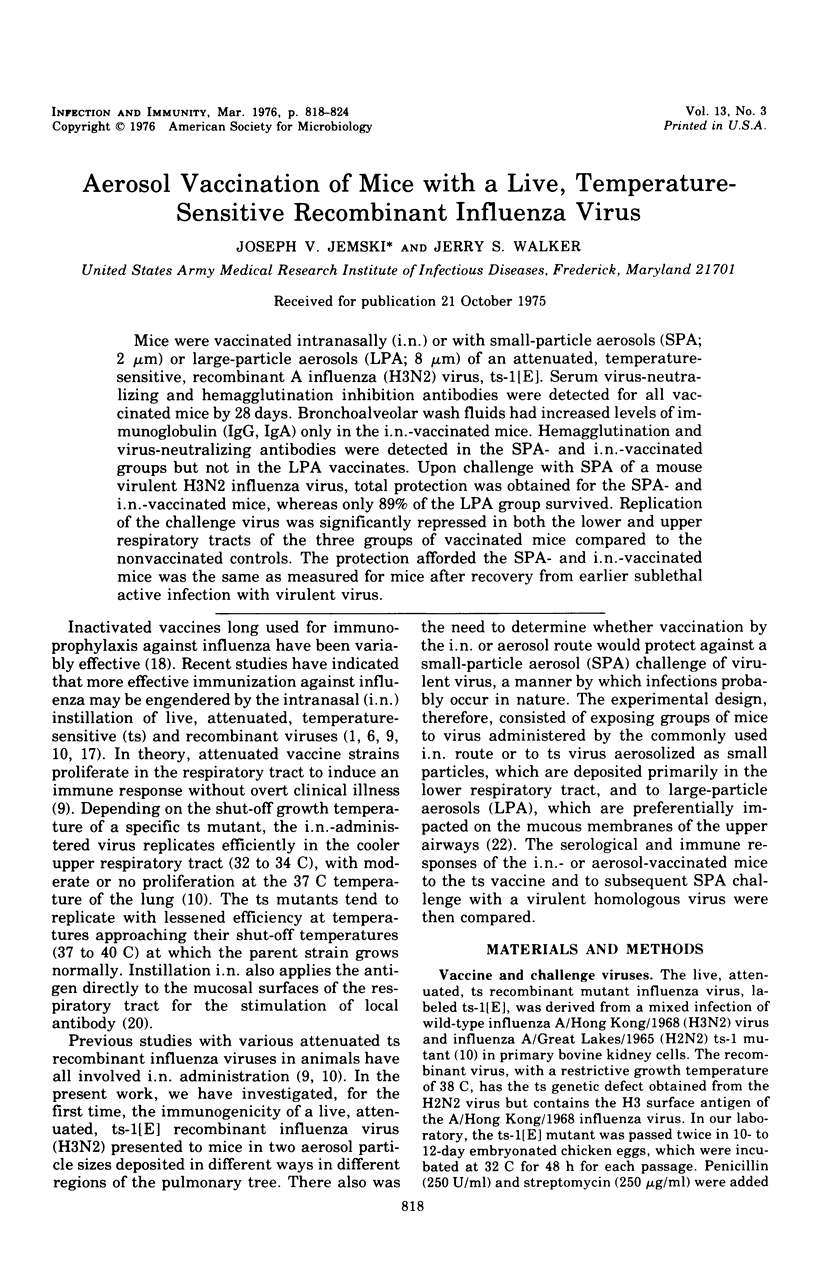
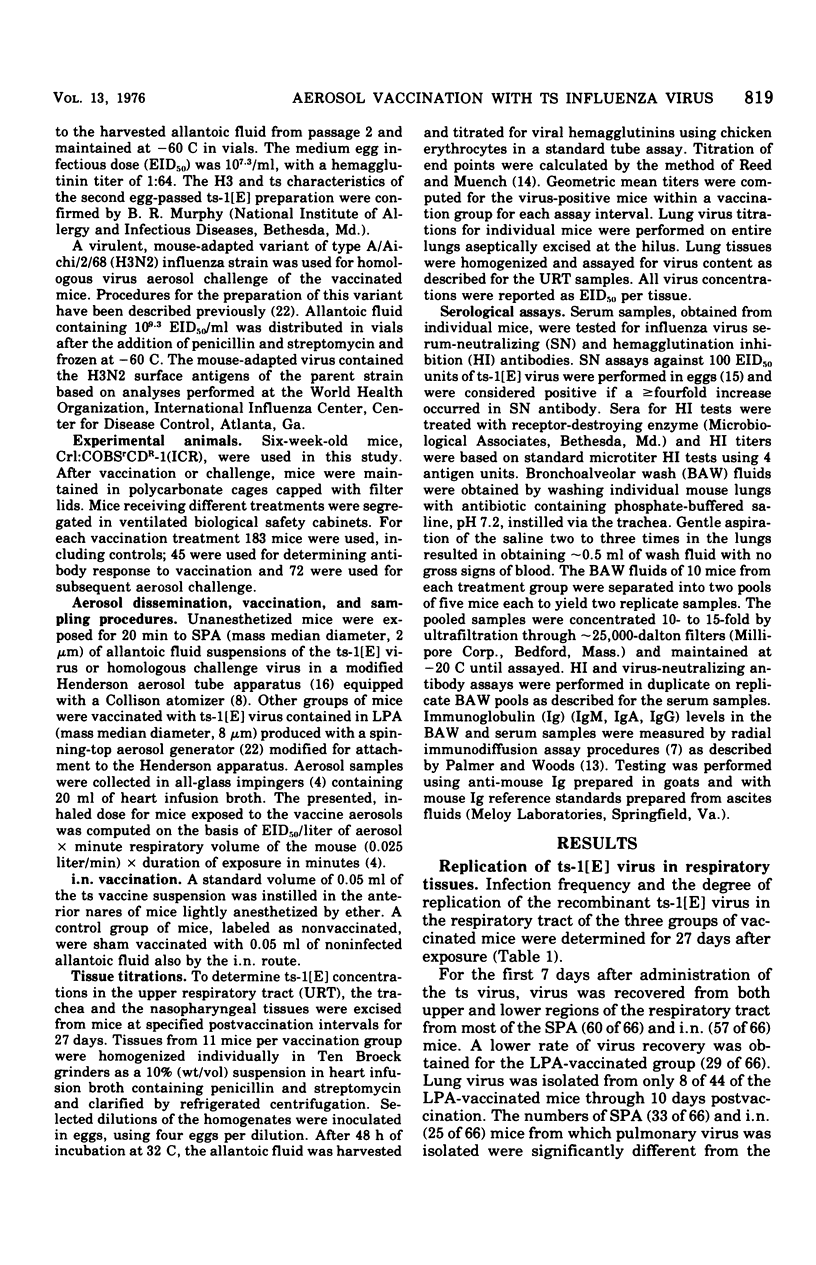
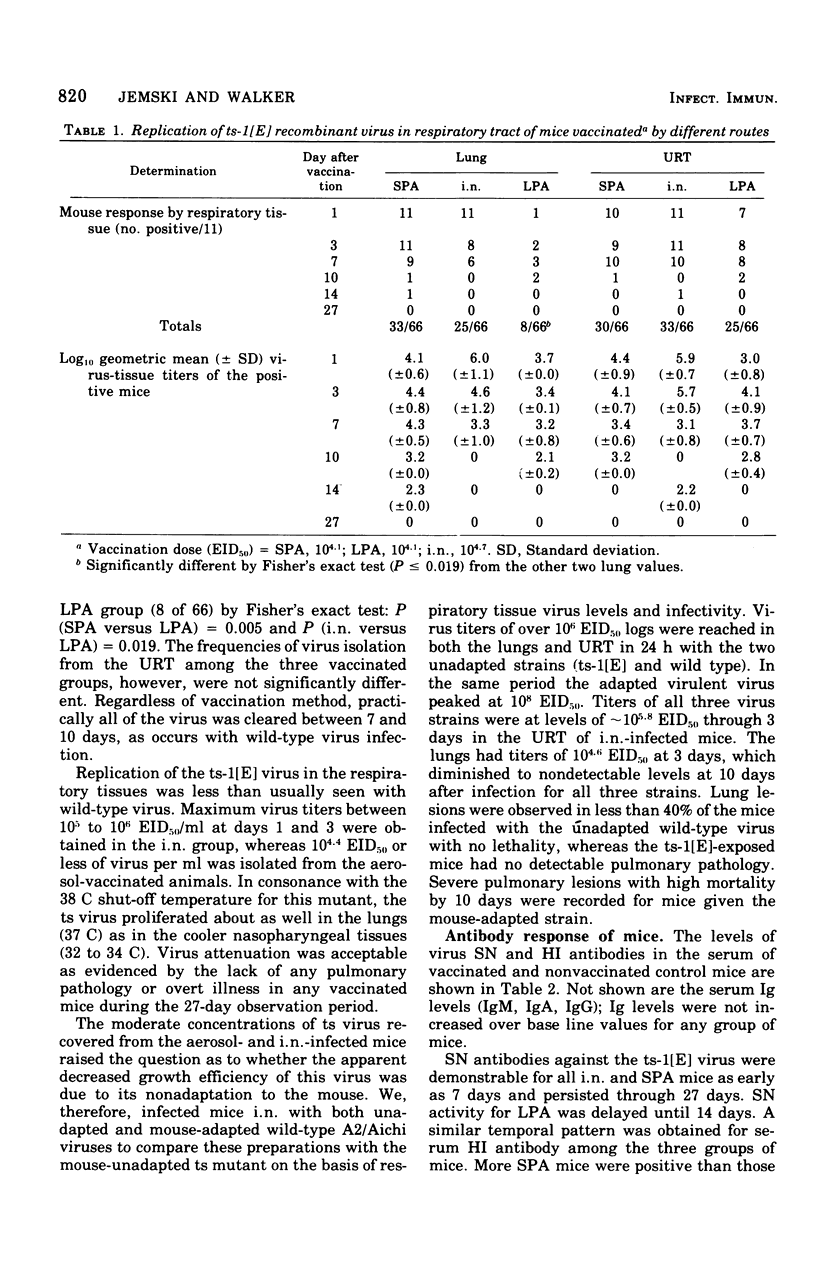
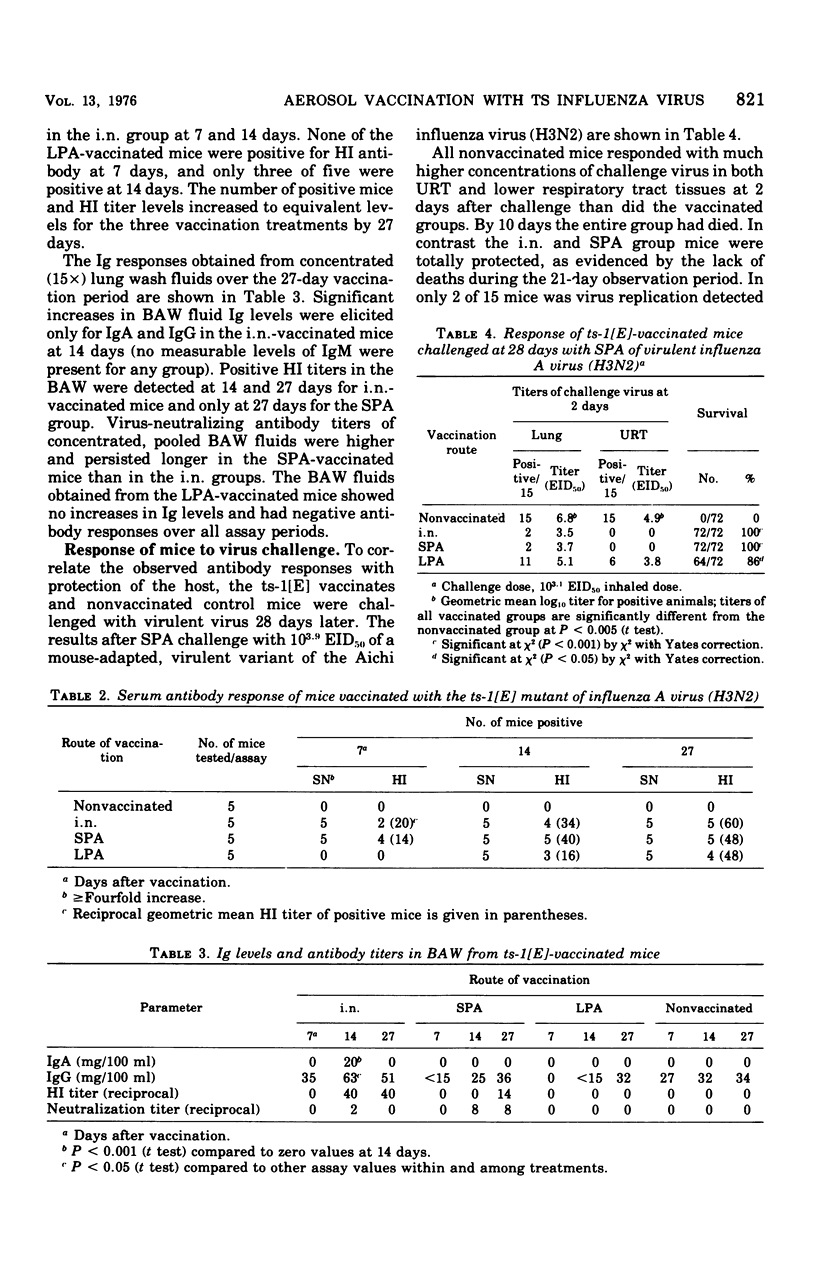

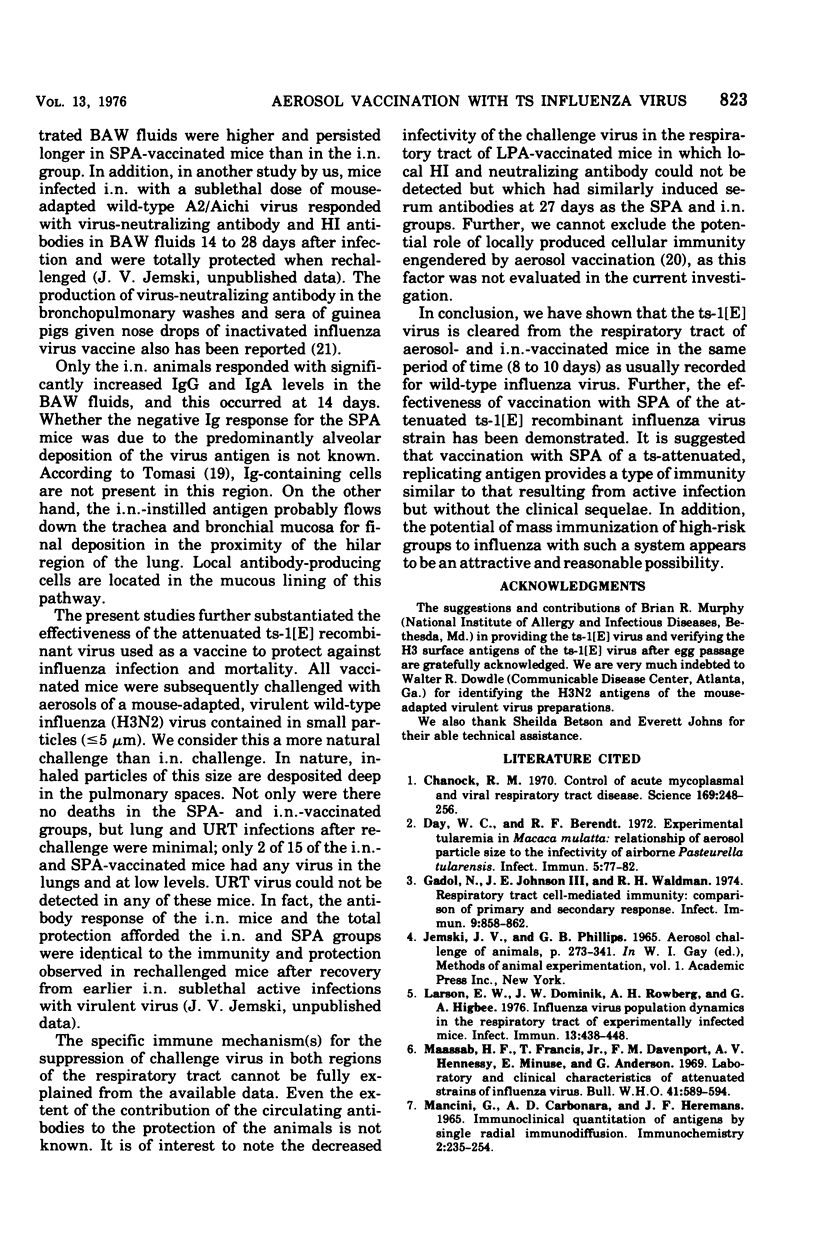

Selected References
These references are in PubMed. This may not be the complete list of references from this article.
- Chanock R. M. Control of acute mycoplasmal and viral respiratory tract disease. Science. 1970 Jul 17;169(3942):248–256. doi: 10.1126/science.169.3942.248. [DOI] [PubMed] [Google Scholar]
- Day W. C., Berendt R. F. Experimental tularemia in Macaca mulatta: relationship of aerosol particle size to the infectivity of airborne Pasteurella tularensis. Infect Immun. 1972 Jan;5(1):77–82. doi: 10.1128/iai.5.1.77-82.1972. [DOI] [PMC free article] [PubMed] [Google Scholar]
- Gadol N., Johnson J. E., 3rd, Waldman R. H. Respiratory tract cell-mediated immunity: comparison of primary and secondary response. Infect Immun. 1974 May;9(5):858–862. doi: 10.1128/iai.9.5.858-862.1974. [DOI] [PMC free article] [PubMed] [Google Scholar]
- Larson E. W., Dominik J. W., Rowberg A. H., Higbee G. A. Influenza virus population dynamics in the respiratory tract of experimentally infected mice. Infect Immun. 1976 Feb;13(2):438–447. doi: 10.1128/iai.13.2.438-447.1976. [DOI] [PMC free article] [PubMed] [Google Scholar]
- Maassab H. F., Francis T., Jr, Davenport F. M., Hennessy A. V., Minuse E., Anderson G. Laboratory and clinical characteristics of attenuated strains of influenza virus. Bull World Health Organ. 1969;41(3):589–594. [PMC free article] [PubMed] [Google Scholar]
- Mancini G., Carbonara A. O., Heremans J. F. Immunochemical quantitation of antigens by single radial immunodiffusion. Immunochemistry. 1965 Sep;2(3):235–254. doi: 10.1016/0019-2791(65)90004-2. [DOI] [PubMed] [Google Scholar]
- Mills J., Chanock V., Chanock R. M. Temperature-sensitive mutants of influenza virus. I. Behavior in tissue culture and in experimental animals. J Infect Dis. 1971 Feb;123(2):145–157. doi: 10.1093/infdis/123.2.145. [DOI] [PubMed] [Google Scholar]
- Murphy B. R., Chalhub E. G., Nusinoff S. R., Chanock R. M. Temperature-sensitive mutants of influenza virus. II. Attenuation of ts recombinants for man. J Infect Dis. 1972 Aug;126(2):170–178. doi: 10.1093/infdis/126.2.170. [DOI] [PubMed] [Google Scholar]
- Murphy B. R., Chalhub E. G., Nusinoff S. R., Kasel J., Chanock R. M. Temperature-sensitive mutants of influenza virus. 3. Further characterization of the ts-1(E) influenza A recombinant (H3N2) virus in man. J Infect Dis. 1973 Oct;128(4):479–487. doi: 10.1093/infdis/128.4.479. [DOI] [PubMed] [Google Scholar]
- Murphy B. R., Hodes D. S., Nusinoff S. R., Spring-Stewart S., Tierney E. L., Chanock R. M. Temperature-sensitive mutants of influenza virus. V. Evaluation in man of an additional ts recombinant virus with a 39 C shutoff temperature. J Infect Dis. 1974 Aug;130(2):144–149. doi: 10.1093/infdis/130.2.144. [DOI] [PubMed] [Google Scholar]
- ROESSLER W. G., KAUTTER D. A. Modifications to the Henderson apparatus for studying air-borne infections. Evaluations using aerosols of Listeria monocytogenes. J Infect Dis. 1962 Jan-Feb;110:17–22. doi: 10.1093/infdis/110.1.17. [DOI] [PubMed] [Google Scholar]
- Schiff G. M., Linnemann C. C., Jr, shea L., Lange B., Rotte T. Evaluation of a live, attenuated recombinant influenza vaccine in high school children. Infect Immun. 1975 Apr;11(4):754–757. doi: 10.1128/iai.11.4.754-757.1975. [DOI] [PMC free article] [PubMed] [Google Scholar]
- Schiff P. Modern trends in immunization. Med J Aust. 1973 Mar 17;1(11):551–557. doi: 10.5694/j.1326-5377.1973.tb110551.x. [DOI] [PubMed] [Google Scholar]
- Waldman R. H., Ganguly R. Immunity to infections on secretory surfaces. J Infect Dis. 1974 Oct;130(4):419–440. doi: 10.1093/infdis/130.4.419. [DOI] [PubMed] [Google Scholar]
- Waldman R. H., Spencer C. S., Johnson J. E., 3rd Respiratory and systemic cellular and humoral immune responses to influenza virus vaccine administered parenterally or by nose drops. Cell Immunol. 1972 Feb;3(2):294–300. doi: 10.1016/0008-8749(72)90168-2. [DOI] [PubMed] [Google Scholar]
- Young H. W., Larson E. W., Dominik J. W. Modified spinning top homogeneous spray apparatus for use in experimental respiratory disease studies. Appl Microbiol. 1974 Dec;28(6):929–934. doi: 10.1128/am.28.6.929-934.1974. [DOI] [PMC free article] [PubMed] [Google Scholar]


